**Announcement: Japanese Guest Houses has a new "sister site" - Japan Roads - for people
who are interested in doing a tour of Japan. For more information, click here.
Just as there are many different
ryokan room prices, there are also many different types or styles of
ryokans. No two ryokans are the same, and the quality of ryokan varies
dramatically. On the low end of the scale is what we call a "standard
ryokan" and at the upper end of the scale is our "luxurious
ryokan." In general, you get what you pay for. On the one hand if
you are only paying 8,000 yen per guest then expect the basic, no-frills, ryokan experience. On the other hand, if you
are paying 40,000 yen per guest then you will probably have an exceptional
ryokan experience with wonderful food, a gorgeous room, a Japanese cypress
bath, a view of a Japanese garden, first-class service, and so on. We
have created a list of ryokan styles to help you better understand the
different types of ryokans and what to expect if you stay at one of them:
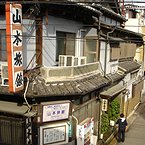 Standard
Ryokan Standard
Ryokan
A standard ryokan offers guests a basic, "no-frills" version
of a Japanese ryokan. The building is usually a plain, concrete
building and it looks more like a small inn or hotel than
a Japanese ryokan. Inside a standard ryokan there is little
traditional atmosphere or character, and while the rooms
are Japanese-style they are very plain and simple. A standard
ryokan is a ryokan experience "on the cheap," a
ryokan experience without the usually higher ryokan prices
found in other traditional or modern-style ryokans.
Modern Ryokan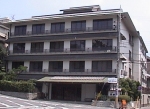
From the outside, a modern ryokan usually looks like
a small hotel and indeed it has all the modern conveniences
of a hotel. It is very comfortable and has Japanese-style
rooms and baths. It is well maintained so both its interior
and exterior look fairly new. There is some traditional Japanese
atmosphere but there is little or no history to the place.
It is close to a Japanese-style hotel but with touches of
traditional Japanese culture here and there. The comfort
of the guests is the number one priority, and the Japanese
cultural experience takes second place.
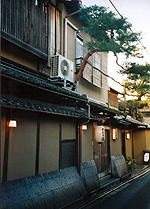 Traditional
Ryokan Traditional
Ryokan
A traditional ryokan is a traditional Japanese inn in
the truest sense of the term. The owners take great pride
in preserving the building's traditional atmosphere and history.
Indeed, the preservation of the ryokan in its original form
is deemed more important than catering to the comfort of
the guests. Staying in a traditional ryokan would be like
staying in a European castle - wonderful atmosphere but at
the expense of hotel-style comfort. The Japanese-style rooms
and baths are comfortable but they can be dark and drafty.
The hallways are also gloomy and there may be few modern
conveniences. The building is made entirely of wood and there
is usually a beautiful, traditional Japanese garden.
Luxurious Ryokan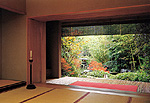
A luxurious ryokan has a long history, traditional atmosphere, and the
owners pamper their guests with comfort and all the modern conveniences.
The owners and staff go out of their way to make sure the guests are
treated like royalty; in other words, Japanese hospitality at its finest.
The Japanese-style rooms and baths are very comfortable, and the traditional, "kaiseki-style" meals
are outstanding. The ryokan is made entirely of wood and there is also
a beautiful Japanese-style garden. Luxurious ryokans are very expensive
and usually located in the major hot spring and tourist areas.
 Ryokan
Hotel Ryokan
Hotel
From the outside, a ryokan hotel looks like a normal hotel and when a
guest enters the building the lobby is like a hotel lobby. A ryokan hotel
also has such amenities as a karaoke room, a bar, a gift shop / convenience
store, a coffee shop, and a restaurant. The ryokan hotel is brightly
lit and very comfortable. The only real difference between a hotel and
a ryokan hotel is the ryokan hotel has Japanese-style rooms and baths
but there may also be Western-style rooms. Guests can also often choose
between having Western or Japanese-style meals.
Here are some other types of accommodation
we provide. These are not true ryokans but they offer a genuine
traditional Japanese cultural experience:
Minshuku
A minshuku is usually a small, wooden, Japanese-style building. The building
is generally not very big, and the rooms are Japanese-style but not
as large as the rooms in Japanese ryokans. While the building and rooms
are usually clean and comfortable, the rooms and hallways can sometimes
be dark and a bit drafty. A minshuku tries to project a "homey" atmosphere
and guests are served home-style Japanese cooking. Minshukus are generally
inexpensive and the owners pride themselves on their friendly, personalized
service.
 Buddhist
Temple Buddhist
Temple
A great way to experience traditional Japanese culture is by staying
at a Buddhist Temple. The most popular places are on Mount Koya (Wakayama
Prefecture) and in Kyoto. Temple lodging is known in Japanese as "shukubo" and
while the style of accommodation can sometimes be basic the cuisine is
often very, very good. The temple monks serve what is known as "shojin
ryori" which is vegetarian cuisine, and at many temples guests are
also welcome to attend the early morning prayer ceremonies.
"Gassho-Zukuri" (traditional thatched
gable roof houses)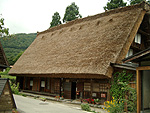
The "gassho-zukuri" are located primarily in Shirakawago, Gifu
Prefecture and Gokayama, Toyama Prefecture. This style of traditional
Japanese architecture means "praying hands." This comes from
the shape of the roof which is thought to resemble two hands clasped
in Buddhist prayer. The steep roof is designed to prevent snow piling
up on the roof, and it also keeps the inside relatively cool in summer.
Another feature is no pegs or nails are used in their construction. and
many contain "irori" (Japanese hearths) in the main central
area. The smoke from these hearths permeate throughout the gassho-zukuri
and have darkened the walls and wood over the years. Traditionally, the
smoke was used to keep the silkworms warm (these buildings were used
to raise silkworms for making silk and the silkworms were raised in frames
in the upper levels of the building). The smoke is also essential to
provide a protective coating for the pine and chestnut pillars and beams
against insects. Warning: the gassho-zukuri are clean and comfortable
but primitive, rustic accommodation. The gassho-zukuri can be dark, gloomy,
and drafty. All bathing and toilet facilities are shared, and local
home-style cuisine is provided to the guests.
Pension
A pension is usually a ferrous concrete Western style building with Western style rooms. You will find these more in northern Japan and near outdoor activities like ski resorts. They are generally family owned and operated. Just like with Minshukus (see above) the owners pride themselves on a friendly and warm atmosphere.
|
